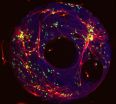(Press-News.org) For decades, autism researchers have faced a baffling riddle: how to unravel a disorder that leaves no known physical trace as it develops in the brain.
Now a UCLA study is the first to reveal how the disorder makes its mark at the molecular level, resulting in an autistic brain that differs dramatically in structure from a healthy one. Published May 25 in the advance online edition of Nature, the findings provide new insight into how genes and proteins go awry in autism to alter the mind.
The discovery also identifies a new line of attack for researchers, who currently face a vast array of potential fronts for tackling the neurological disease and identifying its diverse causes.
"If you randomly pick 20 people with autism, the cause of each person's disease will be unique," said principal investigator Dr. Daniel Geschwind, the Gordon and Virginia MacDonald Distinguished Chair in Human Genetics and a professor of neurology and psychiatry at the David Geffen School of Medicine at UCLA. "Yet when we examined how genes and proteins interact in autistic people's brains, we saw well-defined shared patterns. This common thread could hold the key to pinpointing the disorder's origins."
The research team, led by Geschwind, included scientists from the University of Toronto and King's College London. They compared brain tissue samples obtained after death from 19 autism patients and 17 healthy volunteers. After profiling three brain areas previously linked to autism, the group zeroed in on the cerebral cortex, the most evolved part of the human brain.
The researchers focused on gene expression — how a gene's DNA sequence is copied into RNA, which directs the synthesis of cellular molecules called proteins. Each protein is assigned a specific task by the gene to perform in the cell.
By measuring gene-expression levels in the cerebral cortex, the team uncovered consistent differences in how genes in autistic and healthy brains encode information.
"We were surprised to see similar gene expression patterns in most of the autistic brains we studied," said first author Irina Voineagu, a UCLA postdoctoral fellow in neurology. "From a molecular perspective, half of these brains shared a common genetic signature. Given autism's numerous causes, this was an unexpected and exciting finding."
The researchers' next step was to identify the common patterns. To do this, they looked at the cerebral cortex's frontal lobe, which plays a role in judgment, creativity, emotions and speech, and at its temporal lobes, which regulate hearing, language and the processing and interpreting of sounds.
When the scientists compared the frontal and temporal lobes in the healthy brains, they saw that more than 500 genes were expressed at different levels in the two regions.
In the autistic brains, these differences were virtually non-existent.
"In a healthy brain, hundreds of genes behave differently from region to region, and the frontal and temporal lobes are easy to tell apart," Geschwind said. "We didn't see this in the autistic brain. Instead, the frontal lobe closely resembles the temporal lobe. Most of the features that normally distinguish the two regions had disappeared."
Two other clear-cut patterns emerged when the scientists compared the autistic and healthy brains. First, the autistic brain showed a drop in the levels of genes responsible for neuron function and communication. Second, the autistic brain displayed a jump in the levels of genes involved in immune function and inflammatory response.
"Several of the genes that cropped up in these shared patterns were previously linked to autism," said Geschwind. "By demonstrating that this pathology is passed from the genes to the RNA to the cellular proteins, we provide evidence that the common molecular changes in neuron function and communication are a cause, not an effect, of the disease."
The next step will be for the research team to expand its search for the genetic and related causes of autism to other regions of the brain.
Autism is a complex brain disorder that strikes in early childhood. The disease disrupts a child's ability to communicate and develop social relationships and is often accompanied by acute behavioral challenges. In the United States, autism spectrum disorders are diagnosed in one in 110 children — and one in 70 boys. Diagnoses have expanded tenfold in the last decade.
INFORMATION:
The study was funded by the National Institute of Mental Health, the Canadian Institutes of Health Research, and Genome Canada. Tissue samples were provided by the Autism Tissue Project, the Harvard Brain Bank and the Medical Research Council's London Brain Bank for Neurodegenerative Disease.
Geschwind's and Voineagu's co-authors included Jennifer Lowe, Yuan Tian, Steve Horvath, Jonathan Mill and Rita Cantor of UCLA; Benjamin Blencowe and Xinchen Wang of the University of Toronto; and Patrick Johnston of King's College London.
The UCLA Center for Autism Research and Treatment provides diagnosis, family counseling, clinical trials and treatment for patients with autism. UCLA is one of eight centers in the National Institutes of Health–funded Studies to Advance Autism Research and Treatment network and one of 10 original Collaborative Programs for Excellence in Autism.
For more news, visit the UCLA Newsroom and UCLA News|Week and follow us on Twitter.
END
PASADENA, Calif.—There's a theory about how the Marinoan ice age—also known as the "Snowball Earth" ice age because of its extreme low temperatures—came to an abrupt end some 600 million years ago. It has to do with large amounts of methane, a strong greenhouse gas, bubbling up through ocean sediments and from beneath the permafrost and heating the atmosphere.
The main physical evidence behind this theory has been samples of cap dolostone from south China, which were known to have a lot less of the carbon-13 isotope than is normally found in these types of carbonate rocks. ...
PITTSBURGH—University of Pittsburgh researchers have reproduced the brain's complex electrical impulses onto models made of living brain cells that provide an unprecedented view of the neuron activity behind memory formation.
The team fashioned ring-shaped networks of brain cells that were not only capable of transmitting an electrical impulse, but also remained in a state of persistent activity associated with memory formation, said lead researcher Henry Zeringue [zuh-rang], a bioengineering professor in Pitt's Swanson School of Engineering. Magnetic resonance images ...
VIDEO:
Scientists have known for years that playing violent video games causes players to become more aggressive. The findings of a new University of Missouri study provide one explanation for...
Click here for more information.
COLUMBIA, Mo. – Scientists have known for years that playing violent video games causes players to become more aggressive. The findings of a new University of Missouri (MU) study provide one explanation for why this occurs: the brains of violent ...
EAST LANSING, Mich. — As the use of oral chemotherapy continues to rise, researchers from Michigan State University have discovered many patients fail to properly take the cancer-fighting medication, a significant clinical problem that can result in complications and premature death.
That lack of adherence needs to be addressed by the health care community, said College of Nursing researcher Barbara Given, who led the study that is published in the May edition of Seminars in Oncology Nursing.
"Given the increasing use of oral chemotherapy in treating cancer, patient ...
ANN ARBOR, Mich.---Spending top dollar for megastar players like Miguel Cabrera and Alex Rodriguez helps Major League Baseball teams attract fans and earn higher profits, but clubs that spend the bulk of their player payroll on a couple of superstars ultimately win fewer games, a University of Michigan study shows.
"Superstars who are paid more could bring more to the team in terms of profits," said Jason Winfree, an associate professor of sport management at the U-M School of Kinesiology. "The flip side of that is that a more equitable pay scale among all players results ...
Bethesda, MD—A new research report appearing online in the FASEB Journal (http://www.fasebj.org) shows that what someone drinks after exercise plays a critical role in maximizing the effects of exercise. Specifically, the report shows that protein drinks after aerobic activity increases the training effect after six weeks, when compared to carbohydrate drinks. Additionally, this study suggests that this effect can be seen using as little as 20 grams of protein.
"It is not a mystery that exercise and nutrition help slow the aging process," said Benjamin F. Miller, Ph.D., ...
Medications are the mainstay of treatment for epilepsy, but for a considerable number of patients — estimated to be as many as 1 million in the U.S. — drugs don't work. These patients suffer from a type of epilepsy known as refractory or drug-resistant epilepsy, in which drugs can't control their seizures.
But at an epilepsy conference last month, Dr. Christopher DeGiorgio, a UCLA professor of neurology, presented the results of a non-invasive, non-pharmaceutical treatment that shows promise in controlling seizures.
In his talk at the Antiepileptic Drug Trials XI ...
SEATTLE – Overweight or obese women with less-than-optimal levels of vitamin D who lose more than 15 percent of their body weight experience significant increases in circulating levels of this fat-soluble nutrient, according to a new study by researchers at Fred Hutchinson Cancer Research Center.
"Since vitamin D is generally lower in persons with obesity, it is possible that low vitamin D could account, in part, for the link between obesity and diseases such as cancer, heart disease and diabetes," said Caitlin Mason, Ph.D., lead author of the paper, published online May ...
URBANA – A high-fat diet during pregnancy may program a woman's baby for future diabetes, even if she herself is not obese or diabetic, says a new University of Illinois study published in the Journal of Physiology.
"We found that exposure to a high-fat diet before birth modifies gene expression in the livers of offspring so they are more likely to overproduce glucose, which can cause early insulin resistance and diabetes," said Yuan-Xiang Pan, a U of I professor of nutrition.
The high-fat diet that caused these changes was a typical Western diet that contained 45 percent ...
It is common knowledge that bats and dolphins echolocate, emitting bursts of sounds and then listening to the echoes that bounce back to detect objects. What is less well-known is that people can echolocate too. In fact, there are blind people who have learned to make clicks with their mouths and to use the returning echoes from those clicks to sense their surroundings. Some of these individuals are so adept at echolocation that they can use this skill to navigate unknown environments, and participate in activities such as mountain biking and basketball.
Researchers at ...


